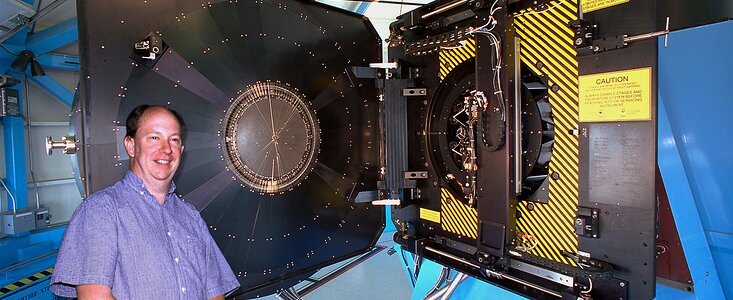NOAO Astronomer Recognized for Development of Multi-Object Spectrograph
17 Junio 1998
Samuel Barden, National Optical Astronomy Observatories (NOAO) , has been awarded the 1998 Maria and Eric Muhlmann Award of the Astronomical Society of the Pacific . The Muhlmann Award is given for innovative advances in astronomical instrumentation, software, or observational infrastructure that enable significant astronomical discoveries. The award to Dr. Barden recognizes his pioneering use of optical fibers with astronomical spectrometers.
For Kitt Peak National Observatory , Dr. Barden led the development of the Hydra Multi-Fiber Positioner, the most successful multi-fiber instrument in astronomy today. Multi-fiber spectrometers enable simultaneous observation of many astronomical objects (up to 100 with Hydra), thus significantly increasing the efficiency of astronomical spectroscopic observations, which are normally made one object at a time.
"I am very pleased that Sam Barden's rare combination of scientific, engineering, and managerial talent has been recognized in this way," said Sidney Wolff, Director of the National Optical Astronomy Observatories. "The Hydra spectrograph is an example of how innovative technology can increase the observing efficiency of a telescope by a factor of 100 or more."
A few scientific discoveries that were made possible using the unique, multi-object capabilities of Hydra include: Catherine Pilachowski (NOAO), in collaboration with several different investigators, has undertaken studies which have led to new understanding of stellar nucleosynthesis, mixing, and evolution of the oldest stars in our galaxy. Lynne Hillenbrand (Univ. of California, Berkeley) and colleagues have identified in young stellar clusters a large number of intermediate mass (3-8 times the mass of the sun) stars which are caught in the act of formation. Phillip Massey (NOAO) et al. conclude that massive stars in associations form in a narrower range of time (less than three million years) than previously thought.
The Hydra Multi-Fiber Positioner is a computer-controlled robot that locates over 100 magnetic buttons holding optical fibers in the telescope focal-plane. As builders of similar instruments at other observatories will testify, automated fiber positioning is very complex to achieve. Hydra was one of the first fiber positioners in operation and has proven to be extremely reliable in use.
Hydra and its associated bench-mounted spectrometer were designed and built by a team of astronomers and engineers at NOAO in Tucson under Dr. Barden's leadership. Hydra was first tested on the KPNO Mayall 4-meter telescope in 1991. For three years, it was the most used instrument on this telescope. In the summer of 1994, Hydra was removed from the Mayall 4-m and rebuilt as the prime facility instrument on the new, 3.5-m WIYN telescope on Kitt Peak . Scientific research with Hydra resumed at WIYN in 1995. Dr. Barden is now working with NOAO engineers to construct a duplicate of WIYN Hydra for use at Cerro Tololo InterAmerican Observatory beginning in 1999.
The Muhlmann Award will be presented to Dr. Barden on 29 June at the Summer Meeting of the ASP in Albuquerque, New Mexico.
Contactos
Suzanne Jacoby
NOAO Press Officer
Tel: (520) 318-8364
Correo electrónico: sjacoby@noao.edu
Dr. Samuel Barden
NOAO Project Scientist
Tel: 520-318-8263
Correo electrónico: sbarden@noao.edu
Dr. Bruce Bohannan
NOAO Project Scientist
Tel: 520-318-8157
Correo electrónico: bbohannan@noao.edu
About the Release
| Release No.: | noao9806 |
| Legacy ID: | NOAO 98-06 |
| Facility: | Nicholas U. Mayall 4-meter Telescope, WIYN 3.5-meter Telescope |



